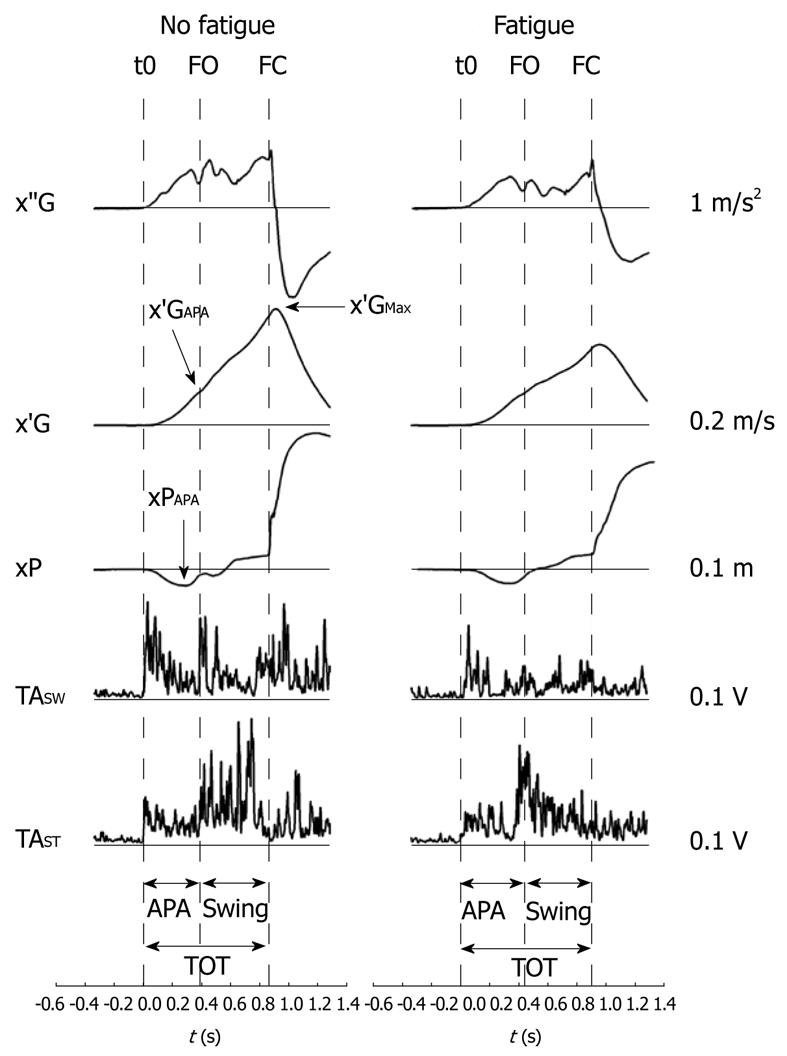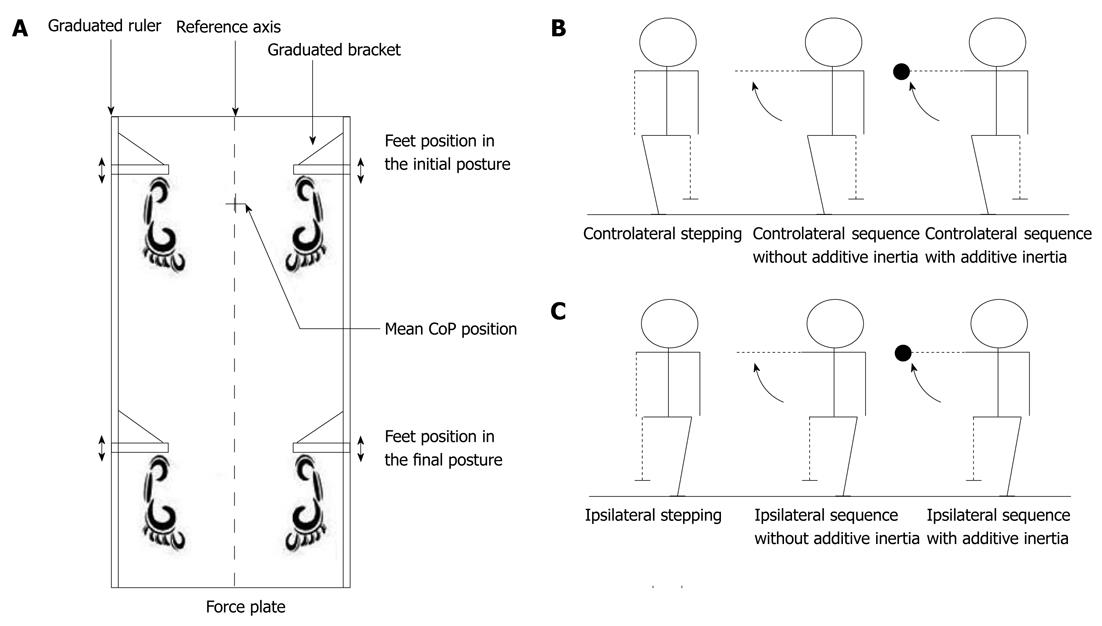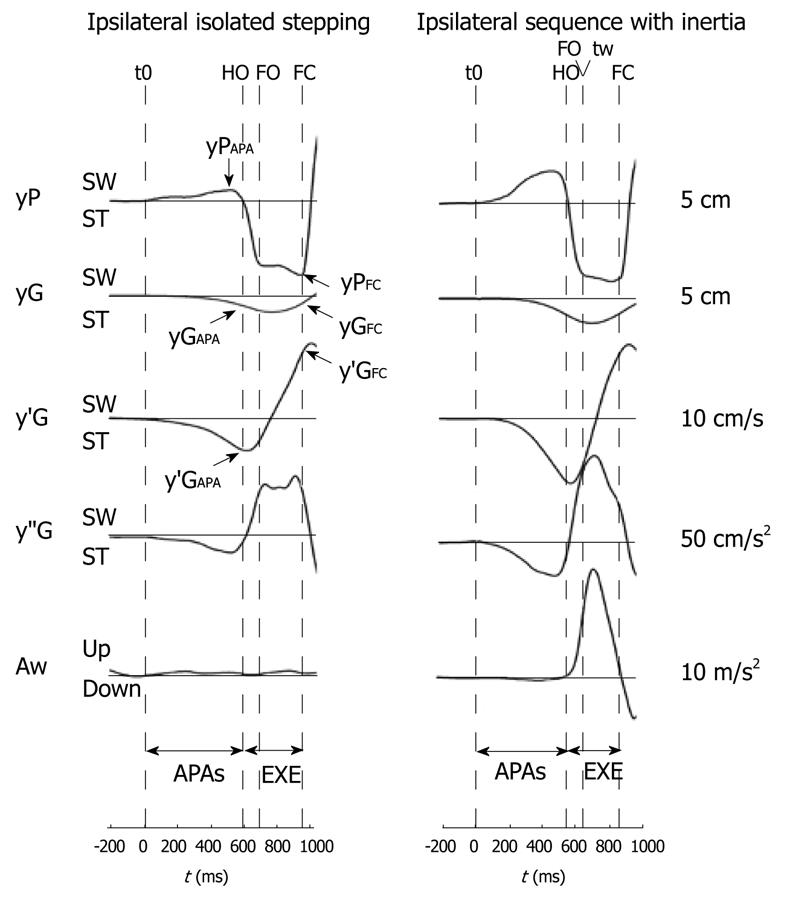Copyright
©2012 Baishideng Publishing Group Co.
Figure 1 Example of biomechanical profiles associated with forward arm pointing in the P0 (heels in contact), P20 (20 cm between the heels) and P40 conditions (40 cm between the heels), and feet position (below panels).
Mean traces (± 1 STD) are presented in one representative subject (n = 7 trials) pointing the arm to the right of the figure. xP, x’’G, AZ, AX: Anteroposterior center of pressure displacement, anteroposterior center of gravity acceleration, vertical and anteroposterior hand acceleration, respectively. Line 1: Onset of biomechanical traces/onset of anticipatory postural adjustments (APA); Line 2: Onset of voluntary hand acceleration; Line 3: Peak of maximal center of pressure displacement/end of APA; Line 4: Target hit. An upward variation indicates a forward or an upward oriented displacement or acceleration. The time scales reported at the bottom of the figure are the same for all panels. The y-scales reported on the left side are the same for the panels in the P0, P20 and P40 conditions. (From Yiou et al[37]) .
Figure 2 Example of biomechanical and electromyographical profiles of stepping initiation in the fatigue and no fatigue condition (one representative participant at spontaneous speed).
x”G, x’G, xP: Anteroposterior center of gravity acceleration, center of gravity velocity and center of pressure displacement, respectively; t0, FO, FC: Onset rise of x’’G trace, swing foot off, swing foot contact, respectively; TA: Rectified electrical activity of tibialis anterior; SW, ST: Swing and stance leg, respectively; APA, SW, TOT: Anticipatory postural adjustments, swing phase and total stepping initiation time windows, respectively; X’GMax, X’GAPA, xPAPA: Peak of center of gravity velocity, center of gravity velocity at foot off, peak of backward center of pressure displacement, respectively. Positive variation of the biomechanical traces indicates forward displacement, velocity or acceleration. Negative variation of these traces indicates backward displacement, velocity or acceleration (from Yiou et al[22]).
Figure 3 Example of the biomechanical traces of leg flexion in the reaction time and self-initiated conditions (one trial in one representative participant).
The figure presents the main experimental variables: yP, y’’G, y’G, yG, z’G, medio-lateral (ML) center of pressure (CoP) displacement, ML center of gravity (CoG) acceleration, ML CoG velocity, ML CoG displacement and vertical CoG velocity. The markers t0, t1, t2 represent respectively the onset variation of the y’’G trace from the baseline, swing heel off and swing foot off. SW and ST indicate the swing and stance leg side, respectively. Finally, yPAPA, y’GFO, yGFO, z’GMax are the peak of ML CoP displacement during APA, ML CoG velocity/displacement at the foot off time, peak of vertical CoG velocity (motor performance), respectively (from Yiou et al[52]).
Figure 4 Example of experimental tasks and setup to investigate the organization of anticipatory postural adjustments in a motor sequence.
A: Experimental setup. The center of pressure and center of gravity displacement are determined relative to the reference line passing through the center of pressure position in the initial posture; B: Experimental tasks involving the controlateral leg for stepping; C: Experimental tasks involving the ipsilateral leg for stepping. Dotted lines represent the body segments involved in raising and stepping (from Yiou et al[32]). CoP: Center of pressure.
Figure 5 Example of biomechanical traces in “ipsilateral isolated stepping” and “ipsilateral stepping + arm raising sequence” with additional inertia (one trial in one representative subject).
yP, yG, y’’G, y’G, Aw: Medio-lateral (ML) center of pressure and center of gravity displacement, ML center of gravity acceleration, ML center of gravity velocity and tangential wrist acceleration, respectively; t0, HO, FO, FC, tw: Onset variation of the yP trace from the reference line, swing heel off, swing foot off, swing foot contact and onset of raising, respectively; SW, ST: Swing and stance leg side, respectively; APAs, EXE: Anticipatory postural adjustments and stepping execution phase, respectively. Main postural variables were reported only in the traces of the “ipsilateral isolated stepping”; yPAPA, yGAPA, y’GAPA: Maximal center of pressure displacement, center of gravity displacement and velocity during APAs; yPFC, yGFC, y’GFC: Center of pressure displacement, center of gravity displacement and velocity at time of swing foot contact. Positive variation of the traces indicates displacement, velocity or acceleration towards the swing leg side. Negative variation of the traces indicates displacement, velocity or acceleration towards the stance leg side (from Yiou et al[32]).
- Citation: Yiou E, Caderby T, Hussein T. Adaptability of anticipatory postural adjustments associated with voluntary movement. World J Orthop 2012; 3(6): 75-86
- URL: https://www.wjgnet.com/2218-5836/full/v3/i6/75.htm
- DOI: https://dx.doi.org/10.5312/wjo.v3.i6.75













